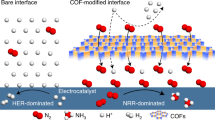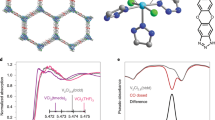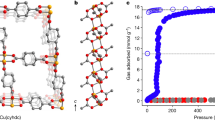Abstract
Selective dinitrogen binding to transition metal ions mainly covers two strategic domains: biological nitrogen fixation catalysed by metalloenzyme nitrogenases1,2,3, and adsorptive purification of natural gas and air4,5,6. Many transition metal–dinitrogen complexes have been envisaged for biomimetic nitrogen fixation to produce ammonia3. Inspired by this concept, here we report mesoporous metal–organic framework materials containing accessible Cr(III) sites, able to thermodynamically capture N2 over CH4 and O2. This fundamental study integrating advanced experimental and computational tools confirmed that the separation mechanism for both N2/CH4 and N2/O2 gas mixtures is driven by the presence of these unsaturated Cr(III) sites that allows a much stronger binding of N2 over the two other gases. Besides the potential breakthrough in adsorption-based technologies, this proof of concept could open new horizons to address several challenges in chemistry, including the design of heterogeneous biomimetic catalysts through nitrogen fixation.
This is a preview of subscription content, access via your institution
Access options
Subscribe to this journal
Receive 12 print issues and online access
$259.00 per year
only $21.58 per issue
Buy this article
- Purchase on Springer Link
- Instant access to full article PDF
Prices may be subject to local taxes which are calculated during checkout




Similar content being viewed by others
References
Thorneley, R. N. F., Eady, R. R. & Lowe, D. J. Biological nitrogen fixation by way of an enzyme-bound dinitrogen-hydride intermediate. Nature 272, 557–558 (1978).
MacKay, B. A. & Fryzuk, M. D. Dinitrogen coordination chemistry: on the biomimetic borderlands. Chem. Rev. 104, 385–401 (2004).
Creutz, S. E. & Peters, J. C. Catalytic reduction of N2 to NH3 by an Fe–N2 complex featuring a C-atom anchor. J. Am. Chem. Soc. 136, 1105–1115 (2014).
Kuznick, S. M. et al. A titanosilicate molecular sieve with adjustable pores for size-selective adsorption of molecules. Nature 412, 720–724 (2001).
Ruthven, D. M. Molecular sieve separations. Chem. Ing. Tech. 83, 44–52 (2011).
Rege, S. U. & Yang, R. T. Limits for air separation by adsorption with LiX zeolite. Ind. Eng. Chem. Res. 36, 5358–5365 (1997).
Cavenati, S., Grande, C. A. & Rodrigues, A. E. Separation of CH4/CO2/N2 mixtures by layered pressure swing adsorption for upgrade of natural gas. Chem. Eng. Sci. 61, 3893–3906 (2006).
Jayaraman, A. et al. Clinoptilolites for nitrogen/methane separation. Chem. Eng. Sci. 59, 2407–2417 (2004).
MacKenzie, D., Cheta, L. & Burns, D. Removing nitrogen. Hydrocarbon Eng. 7, 57–63 (2002).
Baker, R. W. Future directions of membrane gas separation technology. Ind. Eng. Chem. Res. 41, 1393–1411 (2002).
Tagliabue, M. et al. Natural gas treating by selective adsorption: material science and chemical engineering interplay. Chem. Eng. J. 155, 553–566 (2009).
Ghanbaria, H., Pettersson, F. & Saxén, H. Optimal operation strategy and gas utilization in a future integrated steel plant. Chem. Eng. Res. Des. 102, 322–336 (2015).
Majumdar, B. et al. Adsorption and diffusion of methane and nitrogen in barium exchanged ETS-4. Ind. Eng. Chem. Res. 50, 3021–3034 (2011).
Chae, H. K. et al. A route to high surface area, porosity and inclusion of large molecules in crystals. Nature 427, 523–527 (2004).
Matsuda, R. et al. Highly controlled acetylene accommodation in a metal–organic microporous material. Nature 436, 238–241 (2005).
Rodenas, T. et al. Metal–organic framework nanosheets in polymer composite materials for gas separation. Nat. Mater. 14, 48–55 (2015).
Mason, J. A. et al. Methane storage in flexible metal–organic frameworks with intrinsic thermal management. Nature 527, 357–361 (2015).
Krause, S. et al. A pressure-amplifying framework material with negative gas adsorption transitions. Nature 532, 348–352 (2016).
Nugent, P. et al. Porous materials with optimal adsorption thermodynamics and kinetics for CO2 separation. Nature 495, 80–84 (2013).
Yoon, J. W. et al. Controlled reducibility of a metal–organic framework with coordinatively unsaturated sites for preferential gas sorption. Angew. Chem. Int. Ed. 49, 4959–4962 (2010).
Volkringer, C. et al. Infrared spectroscopy investigation of the acid sites in the metal–organic framework aluminum trimesate MIL-100(Al). J. Phys. Chem. C 116, 5710–5719 (2012).
Férey, G. et al. A chromium terephthalate-based solid with unusually large pore volumes and surface area. Science 309, 2040–2042 (2005).
Lee, K. et al. Design of a metal–organic framework with enhanced back bonding for separation of N2 and CH4 . J. Am. Chem. Soc. 136, 698–704 (2014).
Li, J.-R., Sculley, J. & Zhou, H.-C. Metal–organic frameworks for separations. Chem. Rev. 112, 869–932 (2012).
Murray, L. J. et al. Highly-selective and reversible O2 binding in Cr3 (1,3,5-benzenetricarboxylate)2 . J. Am. Chem. Soc. 132, 7856–7857 (2010).
Férey, G. et al. A hybrid solid with giant pores prepared by a combination of targeted chemistry, simulation, and powder diffraction. Angew. Chem. Int. Ed. 43, 6296–6301 (2005).
Volkringer, C. et al. Synthesis, single-crystal X-ray microdiffraction, and NMR characterizations of the giant pore metal–organic framework aluminum trimesate MIL-100. Chem. Mater. 21, 5695–5697 (2009).
Li, L. et al. Separation of CO2/CH4 and CH4/N2 mixtures by M/DOBDC: a detailed dynamic comparison with MIL-100(Cr) and activated carbon. Micropor. Mesopor. Mater. 198, 236–246 (2014).
Hwang, Y. K. et al. Amine grafting on coordinatively unsaturated metal centers of MOFs: consequences for catalysis and metal encapsulation. Angew. Chem. Int. Ed. 47, 4144–4148 (2008).
Vimont, A. et al. Investigation of acid sites in a zeotypic giant pores chromium(III) carboxylate. J. Am. Chem. Soc. 128, 3218–3227 (2006).
Acknowledgements
We would like to acknowledge the financial support from the R&D Convergence Program (CRC-14-1-KRICT) of MSIP (Ministry of Science, ICT and Future Planning) and NST (National Research Council of Science & Technology) of Republic of Korea. KRICT authors thank the Global Frontier Center for Hybrid Interface Materials (GFHIM) for its financial support (Grant No. NRF-2013M3A6B1078879). M.D., G.M. and C.S. thank CNRS (Centre National de la Recherche Scientifique) for its financial support. RGN members acknowledge the financial support through the DRC Program (SKM-1503) funded by NST (National Research Council of Science & Technology) of Korea. G.M. thanks Institut Universitaire de France for its support. Y.J. acknowledges the support from the National Research Foundation of Korea funded by the Korean Government (NRF-2016M3D1A1021147). We thank CCME members for their contributions to the synthesis and characterization of MIL-100(M) samples. J.-S.C. also thanks Y.-U. Kwon (SKKU) for his comment on artificial N2 fixation.
Author information
Authors and Affiliations
Contributions
J.-S.C. designed the study, analysed data and wrote the paper. J.W.Y. and D.-Y.H. performed IR investigations and breakthrough experiments besides the collection of sorption data. F.F., A.V. and M.D. supervised the in situ and operando IR and UV–vis investigations. Y.K.H., S.-K.L. and J.S.L. performed the synthesis of MIL-100(M) materials and their characterizations. Y.-S.B. contributed to the design of this work and to the paper writing. S.-J.L. and T.-U.Y. collected sorption data and performed simulations of breakthrough gas separation. G.M., R.S.P., H.C., S.J., K.K. and Y.J. performed molecular simulations, and G.M. wrote the paper. C.S. and G.F. contributed to the study and the paper writing. All authors discussed the results and commented on the manuscript.
Corresponding authors
Ethics declarations
Competing interests
The authors declare no competing financial interests.
Supplementary information
Supplementary Information
Supplementary Information (PDF 1577 kb)
Rights and permissions
About this article
Cite this article
Yoon, J., Chang, H., Lee, SJ. et al. Selective nitrogen capture by porous hybrid materials containing accessible transition metal ion sites. Nature Mater 16, 526–531 (2017). https://doi.org/10.1038/nmat4825
Received:
Accepted:
Published:
Issue Date:
DOI: https://doi.org/10.1038/nmat4825
This article is cited by
-
Quasi-open Cu(i) sites for efficient CO separation with high O2/H2O tolerance
Nature Materials (2024)
-
Face-directed assembly of tailored isoreticular MOFs using centring structure-directing agents
Nature Synthesis (2023)
-
Soft corrugated channel with synergistic exclusive discrimination gating for CO2 recognition in gas mixture
Nature Communications (2023)
-
Temperature-dependent rearrangement of gas molecules in ultramicroporous materials for tunable adsorption of CO2 and C2H2
Nature Communications (2023)
-
Microporous metal-organic framework materials for efficient capture and separation of greenhouse gases
Science China Chemistry (2023)



